常用微藻培养液配方
- 格式:docx
- 大小:18.75 KB
- 文档页数:7
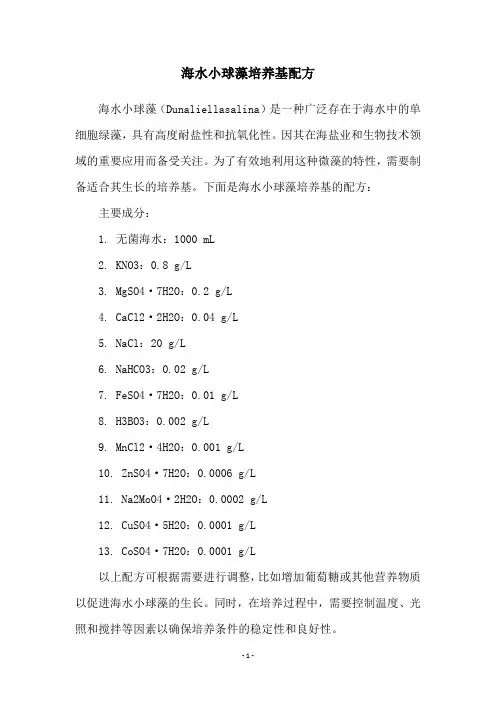
海水小球藻培养基配方
海水小球藻(Dunaliellasalina)是一种广泛存在于海水中的单细胞绿藻,具有高度耐盐性和抗氧化性。
因其在海盐业和生物技术领域的重要应用而备受关注。
为了有效地利用这种微藻的特性,需要制备适合其生长的培养基。
下面是海水小球藻培养基的配方:主要成分:
1. 无菌海水:1000 mL
2. KNO3:0.8 g/L
3. MgSO4·7H2O:0.2 g/L
4. CaCl2·2H2O:0.04 g/L
5. NaCl:20 g/L
6. NaHCO3:0.02 g/L
7. FeSO4·7H2O:0.01 g/L
8. H3BO3:0.002 g/L
9. MnCl2·4H2O:0.001 g/L
10. ZnSO4·7H2O:0.0006 g/L
11. Na2MoO4·2H2O:0.0002 g/L
12. CuSO4·5H2O:0.0001 g/L
13. CoSO4·7H2O:0.0001 g/L
以上配方可根据需要进行调整,比如增加葡萄糖或其他营养物质以促进海水小球藻的生长。
同时,在培养过程中,需要控制温度、光照和搅拌等因素以确保培养条件的稳定性和良好性。

淡水藻类wc培养基配方
淡水藻类的培养基配方通常包括以下成分:无机盐、有机物质、微量元素和维生素。
一般来说,淡水藻类的培养基可以使用以下配方:
1. 硝酸盐,提供氮源,一般使用硝酸铵或硝酸钠。
2. 磷酸盐,提供磷源,一般使用磷酸二氢钾或磷酸氢二钠。
3. 钾盐,提供钾源,一般使用硫酸钾或氯化钾。
4. 硫酸镁,提供镁源。
5. 硫酸钙,提供钙源。
6. 硫酸钠,提供钠源。
7. 硫酸铁,提供铁源。
8. 硫酸锰,提供锰源。
9. 硼酸,提供硼源。
10. 硫酸锌,提供锌源。
11. 硫酸铜,提供铜源。
12. 硫酸钼,提供钼源。
13. 维生素溶液,一般包括硫胺素、核黄素、泛酸、菸酸、生物素、维生素B12等。
14. 有机物质,可以添加葡萄糖、乳糖等有机物质作为碳源。
以上是一般淡水藻类培养基的配方,不同种类的淡水藻可能会有不同的特殊需求,因此在配制培养基时需要根据具体的藻类种类和研究要求进行调整。
同时,培养基的pH值、温度、光照等条件也需要根据具体的淡水藻类进行调整,以促进其生长和繁殖。
希望这些信息能够对你有所帮助。
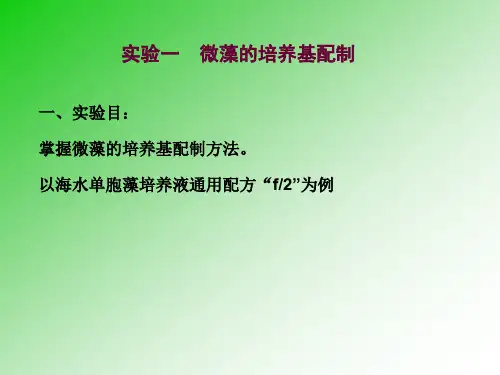
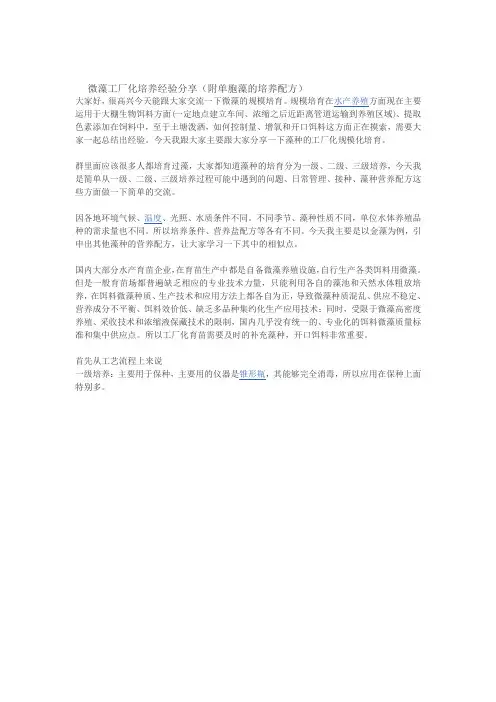
微藻工厂化培养经验分享(附单胞藻的培养配方)大家好,很高兴今天能跟大家交流一下微藻的规模培育。
规模培育在水产养殖方面现在主要运用于大棚生物饵料方面(一定地点建立车间、浓缩之后近距离管道运输到养殖区域)、提取色素添加在饲料中,至于土塘泼洒,如何控制量、增氧和开口饵料这方面正在摸索,需要大家一起总结出经验。
今天我跟大家主要跟大家分享一下藻种的工厂化规模化培育。
群里面应该很多人都培育过藻,大家都知道藻种的培育分为一级、二级、三级培养,今天我是简单从一级、二级、三级培养过程可能中遇到的问题、日常管理、接种、藻种营养配方这些方面做一下简单的交流。
因各地环境气候、温度、光照、水质条件不同。
不同季节、藻种性质不同,单位水体养殖品种的需求量也不同。
所以培养条件、营养盐配方等各有不同。
今天我主要是以金藻为例,引申出其他藻种的营养配方,让大家学习一下其中的相似点。
国内大部分水产育苗企业,在育苗生产中都是自备微藻养殖设施,自行生产各类饵料用微藻。
但是一般育苗场都普遍缺乏相应的专业技术力量,只能利用各自的藻池和天然水体粗放培养,在饵料微藻种质、生产技术和应用方法上都各自为正,导致微藻种质混乱、供应不稳定、营养成分不平衡、饵料效价低、缺乏多品种集约化生产应用技术;同时,受限于微藻高密度养殖、采收技术和浓缩液保藏技术的限制,国内几乎没有统一的、专业化的饵料微藻质量标准和集中供应点。
所以工厂化育苗需要及时的补充藻种,开口饵料非常重要。
首先从工艺流程上来说一级培养:主要用于保种,主要用的仪器是锥形瓶,其能够完全消毒,所以应用在保种上面特别多。
二级培养:主要是用塑料白桶(聚丙烯材料),生产上也用20L的饮水桶,但是瓶口小,操作不方便,消毒也不彻底;而用氧气袋又易破裂。
在南方经常可以见到用玻璃制作的大型鱼缸和氧气袋。
培藻过程中所有的容器和工具,比如锥形瓶、矿泉水桶、搅拌棒等必须经过去污渍、肥皂等刷洗,之后再用消毒后的蒸馏水冲洗3-4遍。
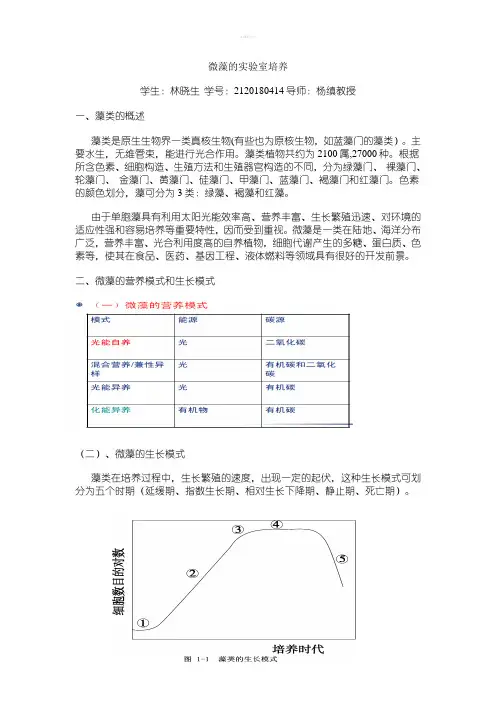
微藻的实验室培养学生:林晓生学号:2120180414导师:杨缜教授一、藻类的概述藻类是原生生物界一类真核生物(有些也为原核生物,如蓝藻门的藻类)。
主要水生,无维管束,能进行光合作用。
藻类植物共约为2100属,27000种。
根据所含色素、细胞构造、生殖方法和生殖器官构造的不同,分为绿藻门、裸藻门、轮藻门、金藻门、黄藻门、硅藻门、甲藻门、蓝藻门、褐藻门和红藻门。
色素的颜色划分,藻可分为3类:绿藻、褐藻和红藻。
由于单胞藻具有利用太阳光能效率高、营养丰富、生长繁殖迅速、对环境的适应性强和容易培养等重要特性,因而受到重视。
微藻是一类在陆地、海洋分布广泛,营养丰富、光合利用度高的自养植物,细胞代谢产生的多糖、蛋白质、色素等,使其在食品、医药、基因工程、液体燃料等领域具有很好的开发前景。
二、微藻的营养模式和生长模式(二)、微藻的生长模式藻类在培养过程中,生长繁殖的速度,出现一定的起伏,这种生长模式可划分为五个时期(延缓期、指数生长期、相对生长下降期、静止期、死亡期)。
三、培养按培养的场所分室内培养和室外培养1)按培养基的形态分固体培养和液体培养2)按培养的纯度分纯种培养和单种培养3)按藻液的流动情况分静止培养和循环流动水培养4)按气体交换情况分充气培养和不充气培养5)按藻液与外界接触程度分封闭式培养和开放式培养6)按培养规模和目的分小型培养、中继培养和大量培养方式简单介绍其中的四种方式:(1)纯培养和单种培养纯培养(axenic culture):是无菌培养,指排除了包括细菌在内的一切生物的条件下进行的培养。
纯培养操作要求十分严格,要求有无菌室、超净台等设备,容器、工具、培养液等均须彻底灭菌。
培养成功率很高,是进行科学研究不可缺少的技术。
单种培养(single-species culture):指区别于纯培养的不排除细菌存在的培养(可以是生产性的,也可以是非生产性的)(2)封闭式培养和开放式培养封闭式培养(closed culture):指把培养液密封在透明的容器中,与外界空气隔离,暴露在阳光中,CO2完全采用人工供给的方法。

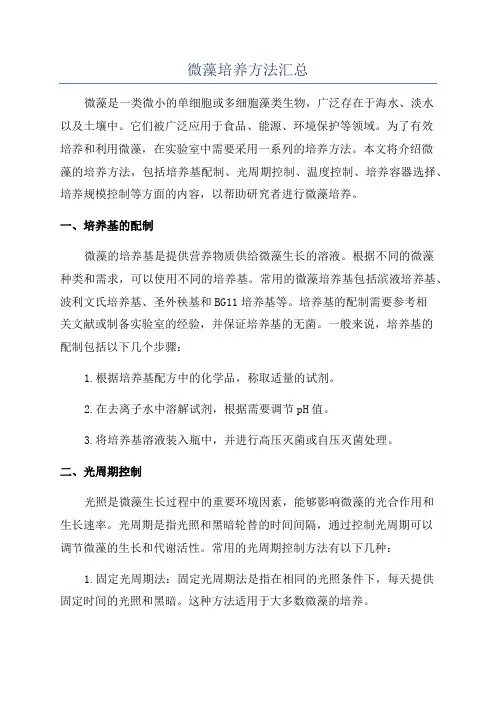
微藻培养方法汇总微藻是一类微小的单细胞或多细胞藻类生物,广泛存在于海水、淡水以及土壤中。
它们被广泛应用于食品、能源、环境保护等领域。
为了有效培养和利用微藻,在实验室中需要采用一系列的培养方法。
本文将介绍微藻的培养方法,包括培养基配制、光周期控制、温度控制、培养容器选择、培养规模控制等方面的内容,以帮助研究者进行微藻培养。
一、培养基的配制微藻的培养基是提供营养物质供给微藻生长的溶液。
根据不同的微藻种类和需求,可以使用不同的培养基。
常用的微藻培养基包括滨液培养基、波利文氏培养基、圣外秧基和BG11培养基等。
培养基的配制需要参考相关文献或制备实验室的经验,并保证培养基的无菌。
一般来说,培养基的配制包括以下几个步骤:1.根据培养基配方中的化学品,称取适量的试剂。
2.在去离子水中溶解试剂,根据需要调节pH值。
3.将培养基溶液装入瓶中,并进行高压灭菌或自压灭菌处理。
二、光周期控制光照是微藻生长过程中的重要环境因素,能够影响微藻的光合作用和生长速率。
光周期是指光照和黑暗轮替的时间间隔,通过控制光周期可以调节微藻的生长和代谢活性。
常用的光周期控制方法有以下几种:1.固定光周期法:固定光周期法是指在相同的光照条件下,每天提供固定时间的光照和黑暗。
这种方法适用于大多数微藻的培养。
2.逐渐增加光周期法:逐渐增加光周期法是指在一段时间内逐渐增加光照时间和减少黑暗时间。
这种方法适用于对光照变化较敏感的微藻。
3.梯度光周期法:梯度光周期法是指提供不同光周期的条件,通过对比不同光周期下的微藻生长情况来选择最适宜的光周期。
三、温度控制微藻的生长和代谢活性受温度影响较大,不同的微藻种类对温度有不同的生长适宜范围。
温度过低或过高都会影响微藻的生长和产物积累。
常用的温度控制方法有以下几种:1.室温培养法:即在室温下进行培养,适用于耐寒性较强的微藻种类。
2.恒温培养法:通过恒温培养箱或恒温培养室维持恒定的培养温度,适用于大多数微藻种类。
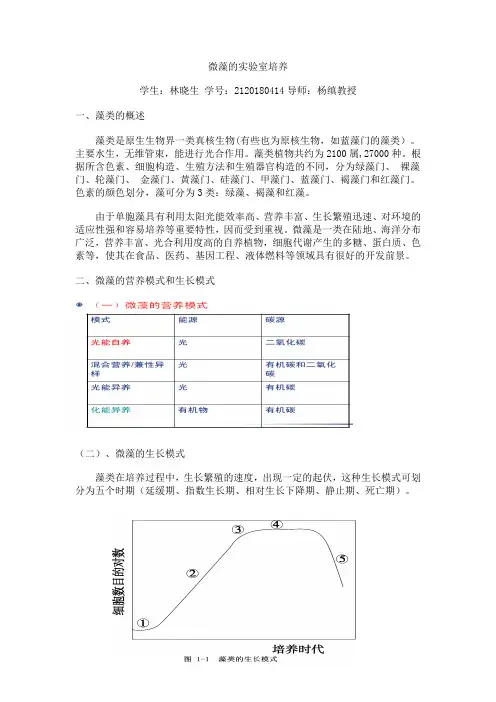
微藻的实验室培养学生:林晓生学号:2120180414导师:杨缜教授一、藻类的概述藻类是原生生物界一类真核生物(有些也为原核生物,如蓝藻门的藻类)。
主要水生,无维管束,能进行光合作用。
藻类植物共约为2100属,27000种。
根据所含色素、细胞构造、生殖方法和生殖器官构造的不同,分为绿藻门、裸藻门、轮藻门、金藻门、黄藻门、硅藻门、甲藻门、蓝藻门、褐藻门和红藻门。
色素的颜色划分,藻可分为3类:绿藻、褐藻和红藻。
由于单胞藻具有利用太阳光能效率高、营养丰富、生长繁殖迅速、对环境的适应性强和容易培养等重要特性,因而受到重视。
微藻是一类在陆地、海洋分布广泛,营养丰富、光合利用度高的自养植物,细胞代谢产生的多糖、蛋白质、色素等,使其在食品、医药、基因工程、液体燃料等领域具有很好的开发前景。
二、微藻的营养模式和生长模式(二)、微藻的生长模式藻类在培养过程中,生长繁殖的速度,出现一定的起伏,这种生长模式可划分为五个时期(延缓期、指数生长期、相对生长下降期、静止期、死亡期)。
三、培养按培养的场所分室内培养和室外培养1)按培养基的形态分固体培养和液体培养 2)按培养的纯度分纯种培养和单种培养3)按藻液的流动情况分静止培养和循环流动水培养 4)按气体交换情况分充气培养和不充气培养 5)按藻液与外界接触程度分封闭式培养和开放式培养6)按培养规模和目的分小型培养、中继培养和大量培养方式简单介绍其中的四种方式:(1)纯培养和单种培养纯培养(axenic culture):是无菌培养,指排除了包括细菌在内的一切生物的条件下进行的培养。
纯培养操作要求十分严格,要求有无菌室、超净台等设备,容器、工具、培养液等均须彻底灭菌。
培养成功率很高,是进行科学研究不可缺少的技术。
单种培养(single-species culture):指区别于纯培养的不排除细菌存在的培养(可以是生产性的,也可以是非生产性的)(2)封闭式培养和开放式培养封闭式培养(closed culture):指把培养液密封在透明的容器中,与外界空气隔离,暴露在阳光中,CO2完全采用人工供给的方法。
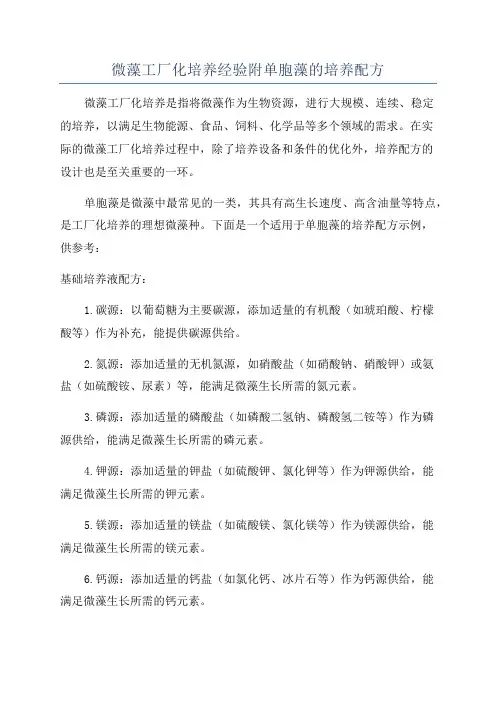
微藻工厂化培养经验附单胞藻的培养配方微藻工厂化培养是指将微藻作为生物资源,进行大规模、连续、稳定的培养,以满足生物能源、食品、饲料、化学品等多个领域的需求。
在实际的微藻工厂化培养过程中,除了培养设备和条件的优化外,培养配方的设计也是至关重要的一环。
单胞藻是微藻中最常见的一类,其具有高生长速度、高含油量等特点,是工厂化培养的理想微藻种。
下面是一个适用于单胞藻的培养配方示例,供参考:基础培养液配方:1.碳源:以葡萄糖为主要碳源,添加适量的有机酸(如琥珀酸、柠檬酸等)作为补充,能提供碳源供给。
2.氮源:添加适量的无机氮源,如硝酸盐(如硝酸钠、硝酸钾)或氨盐(如硫酸铵、尿素)等,能满足微藻生长所需的氮元素。
3.磷源:添加适量的磷酸盐(如磷酸二氢钠、磷酸氢二铵等)作为磷源供给,能满足微藻生长所需的磷元素。
4.钾源:添加适量的钾盐(如硫酸钾、氯化钾等)作为钾源供给,能满足微藻生长所需的钾元素。
5.镁源:添加适量的镁盐(如硫酸镁、氯化镁等)作为镁源供给,能满足微藻生长所需的镁元素。
6.钙源:添加适量的钙盐(如氯化钙、冰片石等)作为钙源供给,能满足微藻生长所需的钙元素。
7.微量元素:添加适量的微量元素(如硼、锌、铁、锰等),能满足微藻生长所需的微量元素。
8.pH调节剂:根据微藻的适宜pH范围,添加适量的pH调节剂(如氢氧化钠、氢氯酸等)使培养液维持稳定的pH值。
此外,在基础培养液的基础上,可以根据微藻的特点和培养目的添加其他的辅助添加物,如调节剂、增酶剂、抗氧化剂、胺基酸等,以进一步优化培养液的成分。
需要注意的是,在进行微藻工厂化培养时,培养液的配方需要根据具体的微藻种类、生长条件、培养目的等因素进行调整,并进行适当的优化和改进。
同时,培养过程中的控制条件如温度、光照强度、光照周期、培养容器等也需要根据实际情况进行合理调整,以达到最佳的生长效果。
总而言之,微藻工厂化培养是一项复杂而关键的工序,其成功与否离不开培养配方的合理设计和整体优化。

(NO.1) 2X Erdschreiber's Medium For UTEX LB 2538DirectionsErdschreiber's Medium made with Supplemented Seawater instead of Pasteurized Seawater. For 3 L Total 1. To 3 L of pasteurized supplemented seawater (60 ppt) aseptically add each of the sterile components in the order specified. 2. Vigorously swirl the contents of the flask to mix thoroughly. 3. Store at refrigerator temperature.1 3 L2 36 mL/3 L3 NaNO3 (FisherBP360-500)10 mL/3 L 0.7 M 2.3 mM4 Na2HPO4·7H2O(Sigma S-9390)10 mL/3 L 0.02 M 0.067 mM5 150 mL/3 L6 3 mL/3 L1)Supplemented SeawaterDirectionsFor 1 L Total 1.To approximately 900 mL of Pasteurized Seawater, add the following components in the order specified while stirring continuously. 2. Bring total volume to 1 L with Pasteurized Seawater.1 900 mL2 NaCl (FisherS271-500)23 g/L 393.8 mM3 MgCl2·6H2O(Fisher M 33)5 g/L 24.6 mM4 Na2SO4 (Sigma S6264)4 g/L 28.2 mMa)Pasteurized SeawaterDirectionsMost salt-water media used by UTEX includes natural seawater collected off-shore from Port Aransas, Texas in the Gulf of Mexico. Seawater having a salinity of at least 30 ppt is collected and pre-filtered, then stored undisturbed withinpolyethylene carboys at ambient temperature.Seawater is diluted to 30 ppt with double distilled water immediately prior to pasteurization. A three-liter batch of seawater at 30 ppt in a 4-liter Erlenmeyer flask is covered with a small inverted glass petri plate and an inverted 250-ml beaker, then "pasteurized" in a steamer for 45 minutes. The pasteurized content of the flask is allowed to cool and left undisturbed at ambient temperature for approximately 24 hr. It is then again steam-pasteurized for 45 min., as on the previous day. After the flask cools the second time, the inverted-petri-plate lid is sealed in place with Parafilm and the flask is stored at refrigerator temperature until it is used to prepare culture medium. This pasteurized seawater may used immediately or may be stored for several months prior to use.Procedure:In various laboratories marine algae are cultured in media prepared from "pasteurized" seawater that is assumed to be heated to exactly 73 degrees C. The procedure described here heats 3-L batches of seawater to over 95 degrees C for two consecutive days, although it does not reach boiling temperature.This procedure generally does not cause precipitation of seawater, although excessive agitation of flasks, the use of scratched or etched flasks, or pasteurization of seawater at higher salinity may result in salt precipitation during heating. Pasteurized seawater prepared as described above appears to be nearly sterile, although it is not used to culture axenic UTEX cultures without further heating in agar. Liquid unialgal cultures grown in media prepared from seawater that has been pasteurized by this method can be sub-cultured for many years without the introduction of invasive contamination.2) P-IV Metal SolutionDirectionsFor 1 L Total Note final concentration listed is for the stock solution. 1.To approximately 950 mL of dH2O, add the nutrients in the order listed while stirring continuously. Note: The Na2EDTA should be fully dissolved before adding other components. 2. Bring total volume to 1 L with dH2O. 3. Store at refrigerator temperature.1 Na2EDTA·2H2O(Sigma ED255)0.75 g/L 2 mM2 FeCl3·6H2O(Sigma F-1513)0.097 g/L 0.36 mM3 MnCl2·4H2O(Baker 2540)0.041 g/L 0.21 mM4 ZnCl2 (Sigma Z-0152)0.005 g/L 0.037 mM5 CoCl2·6H2O(Sigma C-3169)0.002 g/L 0.0084 mM6 Na2MoO4·2H2O(J.T. Baker 3764)0.004 g/L 0.018 mM3) Soilwater: GR+ MediumDirectionsThe basic garden-type soilwater; includes a pinch of CaCO3, which is added to the soil and water prior to steaming; suitable for most phototrophic freshwater algae. Optional ingredients: add vitamin B12 to cultures of Volvox; a pinch of NH4MgPO4. 6H2O added to soilwater cultures of Botryococcus, Synechococcus and some Euglenoids enhances growth and to LB 826 Gonium pectorale increases the numbers of 16-celled colonies formed.For 200 mL Total 1. Combine all components listed. 2. Cover the medium container and steam for 2 consecutive days, 3 hours on each day. Pasteurization is a gradual rising of temperature to approximately 95°C in 15 minutes. Then increased just over 98°C for the 3 hour duration. Cooling occurs gradually at room temperature. 3. Refrigerate 24 hours or more and bring to room temperature before using.1 1 tsp/200 mL dH202 CaCO3 (optional)(Fisher C 64)1 mg/200 mLdH2O0.05 mMa)Green House SoilDirectionsPreparation of the Green house soil:Prior to its use in soil-water media, treat soil in batches by placing it in a heat-resistant pan lined with aluminum foil, fill the soil to a so depth of ¼ inch, and bake at 150°C for 2 hours. After it cools, cover the pan with aluminum foil and store in darkness at room temperature. Avoid excessive moisture during storage. Adaptation of E.G. Pringsheim's biphasic soil-water medium. Variations of this medium are suitable for xenic cultures, especially for isolation purposes and for growing algae to secure "normal" growth forms. Soilwater is not a well-defined medium, yet not all soil is suitable for culturing a broad range of algae. UTEX utilizes soil that was obtained in the early 1970s as greenhouse soil from Indiana University. For a long shelf life it must be kept dry and away from light. UTEX keeps it in sealed 5-gallon plastic containers. There is almost certainly nothing special about the particular soil used by UTEX. However, several considerations are probably important, including the following:1. The soil should be a loam, with a mixture of particle sizes (sand, silt, clay).2. It should contain a moderate amount (15 - 20%) of very-well-decomposed organicmatter. 3. It must not contain pesticides, especially herbicides. 4. It should be soil that has been aged (preferably for 6 months or more) under moist conditions and not, for example, fresh potting soil, soil that contains fresh manure, or soil to which a commercial fertilizer was recently applied. 5. A slightly acidic soil derived from granite or other igneous rock is preferable to soil obtained from calcareous soils. Calcium carbonate can be added to the soilwater medium when it is prepared if a slightly alkaline medium is required. 6. Particulate matter in the soil such as gravel, Perlite, or vermiculite are not necessarily damaging but can be of considerable nuisance when wishing to quantitate the amount of soil used in the medium or when handling algae that are physically associated with the soil. Particulate organic matter, such as compost that is only partially degraded, should be avoided altogether.4) Vitamin B12DirectionsFor 200 mL Total 1. Prepare 200 mL of HEPES buffer (50 mM). 2. Adjust the pH to 7.8. 3. Add Vitamin B12 (0.1 mM) wait until fully dissolved. 4. Sterilize by 0.45 µm Millipore filter. Store in dark at freezer temperature. ** The amount of vitamins added can vary from medium to medium so the final concentration is not listed.1 HEPES buffer pH 7.8(Sigma H-3375)2.4 g/200mL dH2O2 VitaminB12(cyanocobalamin, (Sigma V-6629)0.027g/200 mLdH2O(NO.2)Proteose Medium UTEX 32DirectionsGeneral purpose freshwater medium suitable for axenic cultures. Modified bristol's medium.For 1 L Total pH ~6.8 1. Add proteose peptone to Bristol Medium. *For 1.5% agar medium add 15 g of agar into the flask; do not mix. 2. Cover and autoclave medium.1 1 L2 ProteosePeptone (BD211684)1 g/L 1)Bristol MediumDirectionsH.C. Bold's modification of Bristol's recipe (Bold 1949). General purpose freshwatermedium and as bristol's solution, an essential component of other media--see Bold 1NV, Bold 3N, Bristol-NaCl, LDM, Proteose, Soil extract, and Trebouxia.For 1 L Total 1. To approximately 900 mL of dH2O add each of the components in the order specified while stirring continuously. 2. Bring total volume to 1 L with dH2O. *For 1.5% agar medium add 15 g of agar into the flask; do not mix. 3. Cover and autoclave medium. 4. Store at refrigerator temperature.1 NaNO3 (FisherBP360-500)10 mL/L 10 g/400mL dH2O 2.94 mM2 CaCl2·2H2O(Sigma C-3881)10 mL/L 1 g/400mL dH2O 0.17 mM3 MgSO4·7H2O(Sigma 230391)10 mL/L 3 g/400mL dH2O 0.3 mM4 K2HPO4 (SigmaP 3786)10 mL/L 3 g/400mL dH2O 0.43 mM5 KH2PO4 (SigmaP 0662)10 mL/L 7 g/400mL dH2O 1.29 mM6 NaCl (FisherS271-500)10 mL/L 1 g/400mL dH2O 0.43 mM(NO.3) MES-volvox Medium UTEX 2505DirectionsGeneral purpose medium for freshwater strains, especially those requiring ammonium. Suitable for xenic and axenic cultures. Modified volvox medium.For 1 L Total 1. To approximately 950 mL of dH2O, add each of the components in the order specified (except vitamins) while stirring continuously. 2. Adjust the pH to 6.7. 3. Bring the total volume to 1 L with dH2O. *For 1.5% agar medium add 15 g of agar into the flask; do not mix. 4. Cover and autoclave medium. 5. When cooled add vitamins. *For agar medium add vitamins, mix, and dispense before agar solidifies. 6. Store at refrigerator temperature.1 Ca(NO3)2·4H2O (Sigma C5676)1 mL/L 11.8 g/100 mL dH20 0.5 mM2 MgSO4·7H2O (Sigma230391)1 mL/L 4 g/100 mL dH20 0.16 mM3 Na2glycerophosphate.5H2O(Sigma G 6501 )1 mL/L 5 g/100 mL dH20 0.16 mM4 KCl (Fisher P 217) 1 mL/L5 g/100 mL dH20 0.67 mM5 MES (Sigma M-8250) 1.95 g/L 10 mM6 6 mL/L7 NH4Cl (Fisher A 649-500) 1 mL/L 2.67 g/100 mL dH20 0.5 mM8 1 mL/L91 mL/La)Biotin Vitamin SolutionDirectionsFor 200 mL Total 1. Prepare 200 mL of HEPES buffer (50 mM). 2. Adjust the pH to 7.8. 3. Add biotin (0.1 mM) wait until fully dissolved. 4. Sterilize by 0.45 µm Millipore filter. Store in dark at freezer temperature. ** The amount of vitamins added can vary from medium to medium so the final concentration is not listed.1 HEPES bufferpH 7.8 (SigmaH-3375)2.4 g/200 mLdH2O2 Biotin (SigmaB-4639)0.005 g/200mL dH2O(NO.4)Enriched Seawater Medium UTEX LB 1926DirectionsModification of L. Provasoli's ES-enrichment for seawater a.k.a. PES (Bold & Wynne 1978). General purpose marine medium for xenic cultures.1. Aseptically add 20 mL of sterile ES Enrichment Solution per liter of Pasteurized Seawater (30 ppt).2. Store at refrigerator temperature.1 1 L2 20 mL/L1)Enrichment Solution for Seawater MediumDirectionsFor 2 L Total 1. To approximately 1 L of dH2O, add each of the components in the order specified (except vitamins) while stirring continuously. 2. Adjust the pH to 7.8. 3. Bring the total volume to 2 L with dH2O. 4. Cover and autoclave medium. 5. When cooled add vitamins. 6. Store at refrigerator temperature.1 NaNO3 (Fisher BP360-500) 4.7 g/2 L 27.65 mM2 Na2glycerophosphate.5H2O(Sigma G 6501 )0.7 g/2 L 1.6 mM3 325 mL/2 L4 325 mL/2 L5 HEPES buffer (Sigma H-3375)6.5 g/2 L 14 mM6 3 mL/2 L7 3 mL/2 L8 3 mL/2 La)ES Fe SolutionDirectionsFor 2 L Total 1. To approximately 1.5 L of dH2O, add the following components in the order listed while stirring continuously. 2. Bring total volume to 2 L withdH2O. 3. Store at refrigerator temperature.1 Fe(NH4)2(SO4)2·6H2O(Sigma F-1513)1.4 g/2 L 1.8 mM2 Na2EDTA·2H2O(Sigma ED255)1.2 g/2 L 1.6 mMb)P-II Metal SolutionDirectionsFor 100 mL Total 1. To approximately 70 mL of dH2O, add each of the components in the order specified while stirring continuously. 2. Bring total volume to 100 mL with dH2O. 3. Store at refrigerator temperature. Note: CoCL2 can be interchancable with CoSO4.1 Na2EDTA·2H2O(Sigma ED255)0.1 g/100 mL 0.27 mM2 H3BO3 (Baker0084)0.114 g/100mL1.8 mM3 FeCl3·6H2O(Sigma F-1513)4.9 mg/100mL0.018 mM4 MnSO4·H2O 16.4 mg/100 0.097 mM(Sigma M8179) mL5 ZnSO4·7H2O(Sigma Z 0251)2.2 mg/100mL0.007 mM6 CoCl2·6H2O(Sigma C-3169)0.48 mg/100mL0.002 mMc)Thiamine Vitamin SolutionDirectionsFor 50 mL Total 1. Prepare 50 mL of HEPES buffer (50 mM). 2. Adjust the pH to 7.8. 3. Add Thiamine (6.5 mM) wait until fully dissolved. 4. Sterilize by 0.45 µm Millipore filter. Store in dark at freezer temperature. ** The amount of vitamins added can vary from medium to medium so the final concentration is not listed.1 HEPES bufferpH 7.8 (SigmaH-3375)1.2 g/100 mLdH202 Thiamine(Sigma T-1270)0.11 g/100 mLdH20(NO.5)Soil Extract + Sodium Metasilicate UTEX 640DirectionsModification of Soil Extract Medium for diatoms. For 1 L Total 1. Prepare 1 L of Bristol Medium and thoroughly mix. 2. Discard 40 mL of the Bristol Medium. 3. Add 40 mL of previously prepared GR+ Medium [Note: The GR+ should be filtered to remove soil particles]. * or For 1.5% agar medium add 15 g of agar into the flask; do not mix. 4. Cover and autoclave medium. 5. When cooled, add filter sterilized sodium metasilicate. *For agar medium, add sodium metasilicate, mix, and dispense before agar solidifies. 6. Store at refrigerator temperature.1 960 mL2 40 mL of supernatant3 Sodium Metasilicate 1 mL 200 mM 200 µM(NO.6) Erdschreiber'sMedium UTEX LB 1002 and 2307DirectionsModified from the original Plymouth seawaterrecipe. General purpose marine medium forxenic cultures [for bacteria-free cultures seereprints in Rosowski & Parker (1971)].For 3 L Total 1. To 3 L of pasteurized filtered seawater (30 ppt) aseptically add each of the sterile components in the order specified. 2. Vigorously swirl the contents of the flask to mix thoroughly. 3. Store at refrigerator temperature.1 3 L2 36 mL/3 L3 NaNO3(autoclave beforeadding) (Fisher BP360-500)10 mL/3L0.7 M 2.3 mM4 Na2HPO4·7H2O (autoclavebefore adding) (Sigma S-9390)10 mL/3L0.02 M 0.067 mM5 150 mL/3 L6 3 mL/3 L(NO.7)TAP medium (original )from Gorman, D.S., and R.P. Levine (1965) Proc. Natl. Acad. Sci. USA54, 1665-1669. This is probably the most widely-used medium at present for experimental work.Make the following stock solutions:1. TAP saltsNH4Cl 15.0 gMgSO4 . 7H2O 4.0 gCaCl2 . 2H2O 2.0 gwater to 1 liter2. phosphate solutionK2HPO428.8 gKH2PO414.4 gwater to 100 ml3. Hutner's trace elements (follow this )To make the final medium, mix the following:2.42 g Tris25 ml solution #1 (salts)0.375 ml solution #2 (phosphate)1.0 ml solution #3 (trace elements)1.0 ml glacial acetic acidwater to 1 literFor solid medium, add 15 g agar per literAutoclave.For Tris-minimal medium omit the acetic acid and titrate the final solution to pH 7.0 with HCl(1)Hutner's trace elementsHutner et al. (1950) Proc. Am. Philos. Soc.94, 152-170This mixture is used both in and in the medium.For a detailed analysis of how well this trace elements solution meets the nutritional requirements of C. reinhardtii, see Merchant et al. (2006) Biochim. Biophys. Acta1763, 578-594.For 1 liter final mix, dissolve each compound in the volume of water indicated.百度文库 - 让每个人平等地提升自我11 The EDTA should be dissolved in boiling water, and the FeSO4 should be prepared last to avoid oxidation.compound amount waterEDTA disodium salt 50 g 250 mlZnSO4 . 7 H2O 22 g 100 mlH3BO311.4 g 200 mlMnCl2 . 4 H2O 5.06 g 50 mlCoCl2. 6 H2O 1.61 g 50 mlCuSO4 . 5 H2O 1.57 g 50 ml(NH4)6Mo7O24. 4 H2O 1.10 g 50 mlFeSO4. 7 H2O 4.99 g 50 mlMix all solutions except EDTA. Bring to boil, then add EDTA solution. The mixture should turn green. When everything is dissolved, cool to 70 degrees C. Keeping temperature at 70, add 85 ml hot 20% KOH solution (20 grams / 100 ml final volume). Do NOT use NaOH to adjust the pH.Bring the final solution to 1 liter total volume. It should be clear green initially. Stopper the flask with a cotton plug and let it stand for 1-2 weeks, shaking it once a day. The solution should eventually turn purple and leave a rust-brown precipitate, which can be removed by filtering through two layers of Whatman#1 filter paper, repeating the filtration if necessary until the solution is clear. Store refrigerated or frozen convenient aliquots. Some people shorten the time for formation of the precipiate by bubbling the solution with filtered air.If no precipitate forms, the solution is still usable. However, you might want to check the pH in this case and adjust it to around 7.0 using either KOH or HCl as needed.To prepare sulfur-free trace elements for hydrogen generation, the sulfate salts can be replaced with equimolar chloride salts (ZnCl2 10.0 g; CuCl2 . 2 H2O 1.00 g; FeCl2 . 4 H2O, 3.60 g). .。

藻种培养:1.藻种培养设施:藻种的培养要在保种室中进行,保种室要求通风条件好,光线条件好,温度可控性好,保种室要配有空调、冰箱、具有人工光源的培养架等。
培养中常用培养仪器有显微镜、解剖镜等,容器有三角烧瓶、广口玻璃瓶等。
保种室要严格消毒,防止病菌的侵入。
2.容器、工具的消毒:进行单细胞藻类的纯培养,容器、工具、培养基都要进行严格灭菌,但一般生产性的单种培养,则只须达到消毒目的就可以了。
常用的消毒方法有高温消毒法和化学药品消毒法。
高温消毒法是利用高温杀死微生物的方法。
不耐高温的容器如塑料和橡胶制品等不能利用高温法消毒。
a、直接灼烧消毒接种环、镊子等金属小工具,试管口、瓶口等可以直接在酒精灯火焰上短暂灼烧消毒。
载玻片、小刀等则最好先蘸酒精,然后在酒精灯火焰上点燃,等器具上的酒精烧完,也就完成了灭菌操作。
b、煮沸消毒把容器、工具放入锅中,加水煮沸消毒,一般煮沸10-20分钟。
大型锥形瓶消毒,可在瓶口上放一普通的玻璃漏斗,再在漏斗上放一称量瓶盖,在锥形瓶内加少量淡水,置电炉上加热煮沸5-10分钟,可使整个瓶壁消毒。
消毒完毕即用消毒的纸或消毒的纱布包扎瓶口。
此法适合消毒小型的容器工具。
c、烘箱干燥消毒将玻璃容器、金属工具用清水洗干净后,放入烘箱。
关闭烘箱门,打开通气孔,接通电源加热。
当温度上升到120℃时,关闭通气孔,停止加热。
如果进行纯培养,容器必须灭菌,当温度上升到105℃时,关闭通气孔,继续加热至160℃,保持温度,恒温2小时,然后停止加热。
必须要等到温度下降到60℃以下,才能打开烘箱门。
有棉塞和纸包扎的容器、工具灭菌,不能超过180℃,以免烘焦。
化学药品消毒主要用于生产性大量培养中,大型容器、工具、水泥池等常用化学药剂消毒。
a、漂白粉消毒工业用漂白粉一般含有效氯25%~35%,消毒时按万分之1-3的含量配成水溶液,把容器、工具在溶液中浸泡半小时,再用消毒水冲洗3~4次即可。
b、酒精消毒酒精消毒常用于中小形容器和工具,方法是用纱布蘸70%酒精在容器、工具的表面涂抹即可。
二、常用微藻培养液配方微藻种类不同,培养液的配制方法也不同,即使同一种类,个人的惯用方法也不同。
现将硅藻、金藻、绿藻、黄藻和蓝藻常用的培养液配方介绍如下:(一)硅藻类培养液1、三角褐指藻、新月菱形藻培养液(1)人尿5毫升海泥抽取液20-50毫升海水1000毫升2、三角褐指藻、新月菱形藻培养液(2)硫酸铵[(NH4)2SO4]或硝酸铵(NH4NO3)30毫克过磷酸钙发酵尿液3毫升柠檬酸铁(FeC6H5O7) 0.5毫克海水1000毫升过磷酸钙发酵尿液是将1%的过磷酸钙加入尿中发酵而成,可补充尿液中的磷肥不足和保持氮肥。
3、三角褐指藻、新月菱形藻培养液(3)人尿1.5-2毫升硝酸钠(NaNO3) 50毫克磷酸二氢钾(KH2PO4)5毫克硫酸铁[Fe2(SO4)3](1%溶液)5滴柠檬酸钠(2Na3C6H507·11H2O) 10毫克硅酸钠(Na2SiO3) 10毫克维生素B12 0.2微克海水1000毫升适于小型和中继培养,加入10-20毫升海泥抽取液效果更好。
4、三角褐指藻、新月菱形藻培养液(4)硝酸铵(NH4NO3)30-50毫克磷酸二氢钾(KH2PO4)3-5毫克柠檬酸铁铵[Fe(NH4)3(C6H5O7)] 0.5-1.0毫克硅酸钾(K2SiO3) 20毫克海水1000毫升5、厄尔德-施赖伯培养液硝酸钠(NaNO3) 100毫克磷酸氢二钠(Na2HPO4·12H2O)20毫克海水1000毫克是最简单的配方,适应于硅藻的培养。
6、黄海所角毛藻培养液硝酸铵(NH4NO3) 5-20毫克磷酸二氢钾(KH2PO4)0.5-1.0毫克柠檬酸铁(FeC6H5O7) 0.5-2.0毫克海水1000毫升加入少量人尿,效果更好。
7、生产上用硅藻培养液硝酸钠60克(或15克硝酸钠+20尿素)磷酸二氢钾(KH2PO4)4克硅酸钠(Na2SiO3) 4.5克柠檬酸铁(FeC6H5O7) 0.045克消毒海水1米3适合生产上培养三角指藻、新月菱形藻和角毛藻。
淡水藻类wc培养基配方全文共四篇示例,供读者参考第一篇示例:淡水藻类是一类生长在淡水环境中的微藻,以其在生态系统中的重要作用而备受关注。
为了研究淡水藻类的生长特性和生态学特征,科研人员经常需要利用培养基来培养淡水藻类。
淡水藻类wc培养基是一种常用的培养基,能够提供淡水藻类所需的营养物质和生长条件,促进其生长和繁殖。
淡水藻类wc培养基的配方包括多种成分,包括碳源、氮源、磷源、微量元素和维生素等。
下面我们将详细介绍一份常用的淡水藻类wc培养基配方:主要成分:1. 水:1000mL2. NaNO3(硝酸钠):0.1g3. K2HPO4(磷酸氢二钾):0.02g4. MgSO4(硫酸镁):0.2g5. CaCl2(氯化钙):0.02g6. FeSO4(硫酸亚铁):0.001g7. EDTA-Na2(二乙二胺四乙酸二钠):0.001g8. H3BO3(硼酸):0.00004g9. MnCl2(氯化锰二水合物):0.0001g10. ZnSO4(硫酸锌):0.0001g11. CuSO4(硫酸铜):0.0001g12. CoCl2(氯化钴):0.0001g13. MoO3(氧化钼):0.0001g14. NiSO4(硫酸镍):0.0001g15. Vitamin B1(硫胺素):0.0001g制备方法:1. 将硝酸钠、磷酸氢二钾、硫酸镁、氯化钙、硫酸亚铁、二乙二胺四乙酸二钠、硼酸、氯化锰二水合物、硫酸锌、硫酸铜、氯化钴、氧化钼、硫酸镍、硫胺素分别称量并溶解于水中,得到氮源、磷源、镁离子、钙离子、铁离子、螯合剂和微量元素的溶液。
2. 将上述溶液混合均匀成淡水藻类wc培养基溶液。
3. 调节溶液的pH值为7.0-7.5。
4. 将培养基溶液装入适量的培养瓶或培养皿中。
5. 通过高压灭菌或过滤等方法对培养基进行消毒处理。
淡水藻类wc培养基的配方中包含了各种重要的营养物质,如氮源、磷源、微量元素和维生素等,能够满足淡水藻类的生长和繁殖需要。
微藻工厂化培养经验分享(附单胞藻的培养配方)在主要运用于大棚生物饵料方面 一定地点建立车间、浓缩之后近距离管道运输到养殖区域 、提取色素添加在饲料中,至于土塘泼洒,如何控制量、增氧和开口饵料这方面正在摸索,需要大家一起总结出经验。
今天我跟大家主要跟大家分享一下藻种的工厂化规模化培育。
群里面应该很多人都培育过藻,大家都知道藻种的培育分为一级、二级、三级培养,今天我是简单从一级、二级、三级培养过程可能中遇到的问题、日常管理、接种、藻种营养配方这些方面做一下简单的交流。
养殖品种的需求量也不同。
所以培养条件、营养盐配方等各有不同。
今天我主要是以金藻为例,引申出其他藻种的营养配方,让大家学习一下其中的相似点。
国内大部分水产育苗企业,在育苗生产中都是自备微藻养殖设施,自行生产各类饵料用微藻。
但是一般育苗场都普遍缺乏相应的专业技术力量,只能利用各自的藻池和天然水体粗放培养,在饵料微藻种质、生产技术和应用方法上都各自为正,导致微藻种质混乱、供应不稳定、营养成分不平衡、饵料效价低、缺乏多品种集约化生产应用技术;同时,受限于微藻高密度养殖、采收技术和浓缩液保藏技术的限制,国内几乎没有统一的、专业化的饵料微藻质量标准和集中供应点。
所以工厂化育苗需要及时的补充藻种,开口饵料非常重要。
首先从工艺流程上来说一级培养:主要用于保种,主要用的仪器是锥形瓶,其能够完全消毒,所以应用在保种上面特别多。
二级培养:主要是用塑料白桶(聚丙烯材料),生产上也用 的饮水桶,但是瓶口小,操作不方便,消毒也不彻底;而用氧气袋又易破裂。
在南方经常可以见到用玻璃制作的大型鱼缸和氧气袋。
回复举报 来自 客户端 楼•••••知名人士三级培养:主要有小型的 、 、 左右的室内水泥池,采光良好,白色透明玻璃钢瓦或塑料薄膜于车间顶部用于培育藻种。
接下来我主要简单的讲一下容器和工具的洗涤、消毒。
培藻过程中所有的容器和工具,比如锥形瓶、矿泉水桶、搅拌棒等必须经过去污渍、肥皂等刷洗,之后再用消毒后的蒸馏水冲洗 遍。
二、常用微藻培养液配方微藻种类不同,培养液的配制方法也不同,即使同一种类,个人的惯用方法也不同。
现将硅藻、金藻、绿藻、黄藻和蓝藻常用的培养液配方介绍如下:(一)硅藻类培养液1、三角褐指藻、新月菱形藻培养液(1)人尿5毫升海泥抽取液20-50毫升海水1000毫升2、三角褐指藻、新月菱形藻培养液(2)硫酸铵[(NH4)2SO4]或硝酸铵(NH4NO3)30毫克过磷酸钙发酵尿液3毫升柠檬酸铁(FeC6H5O7) 0.5毫克海水1000毫升过磷酸钙发酵尿液是将1%的过磷酸钙加入尿中发酵而成,可补充尿液中的磷肥不足和保持氮肥。
3、三角褐指藻、新月菱形藻培养液(3)人尿1.5-2毫升硝酸钠(NaNO3) 50毫克磷酸二氢钾(KH2PO4)5毫克硫酸铁[Fe2(SO4)3](1%溶液)5滴柠檬酸钠(2Na3C6H507·11H2O) 10毫克硅酸钠(Na2SiO3) 10毫克维生素B12 0.2微克海水1000毫升适于小型和中继培养,加入10-20毫升海泥抽取液效果更好。
4、三角褐指藻、新月菱形藻培养液(4)硝酸铵(NH4NO3)30-50毫克磷酸二氢钾(KH2PO4)3-5毫克柠檬酸铁铵[Fe(NH4)3(C6H5O7)] 0.5-1.0毫克硅酸钾(K2SiO3) 20毫克海水1000毫升5、厄尔德-施赖伯培养液硝酸钠(NaNO3) 100毫克磷酸氢二钠(Na2HPO4·12H2O)20毫克海水1000毫克是最简单的配方,适应于硅藻的培养。
6、黄海所角毛藻培养液硝酸铵(NH4NO3) 5-20毫克磷酸二氢钾(KH2PO4)0.5-1.0毫克柠檬酸铁(FeC6H5O7) 0.5-2.0毫克海水1000毫升加入少量人尿,效果更好。
7、生产上用硅藻培养液硝酸钠60克(或15克硝酸钠+20尿素)磷酸二氢钾(KH2PO4)4克硅酸钠(Na2SiO3) 4.5克柠檬酸铁(FeC6H5O7) 0.045克消毒海水1米3适合生产上培养三角指藻、新月菱形藻和角毛藻。
常用微藻培养液配方
二、常用微藻培养液配方
微藻种类不同,培养液的配制方法也不同,即使同一种类,个人的惯用方法也不同。
现将硅藻、金藻、绿藻、黄藻和蓝藻常用的培养液配方介绍如下:
(一)硅藻类培养液
1、三角褐指藻、新月菱形藻培养液(1)
人尿5毫升
海泥抽取液20-50毫升
海水1000毫升
2、三角褐指藻、新月菱形藻培养液(2)
硫酸铵[(NH4)2SO4]或硝酸铵(NH4NO3)30毫克
过磷酸钙发酵尿液3毫升
柠檬酸铁(FeC6H5O7) 0.5毫克
海水1000毫升
过磷酸钙发酵尿液是将1%的过磷酸钙加入尿中发酵而成,可补充尿液中的磷肥不足和保持氮肥。
3、三角褐指藻、新月菱形藻培养液(3)
人尿1.5-2毫升
硝酸钠(NaNO3) 50毫克
磷酸二氢钾(KH2PO4)5毫克
硫酸铁[Fe2(SO4)3](1%溶液)5滴
柠檬酸钠(2Na3C6H507·11H2O) 10毫克
硅酸钠(Na2SiO3) 10毫克
维生素B12 0.2微克
海水1000毫升
适于小型和中继培养,加入10-20毫升海泥抽取液效果更好。
4、三角褐指藻、新月菱形藻培养液(4)
硝酸铵(NH4NO3)30-50毫克
磷酸二氢钾(KH2PO4)3-5毫克
柠檬酸铁铵[Fe(NH4)3(C6H5O7)] 0.5-1.0毫克硅酸钾(K2SiO3) 20毫克
海水1000毫升
5、厄尔德-施赖伯培养液
硝酸钠(NaNO3) 100毫克
磷酸氢二钠(Na2HPO4·12H2O)20毫克
海水1000毫克
是最简单的配方,适应于硅藻的培养。
6、黄海所角毛藻培养液
硝酸铵(NH4NO3) 5-20毫克
磷酸二氢钾(KH2PO4)0.5-1.0毫克
柠檬酸铁(FeC6H5O7) 0.5-2.0毫克
海水1000毫升
加入少量人尿,效果更好。
7、生产上用硅藻培养液
硝酸钠60克(或15克硝酸钠+20尿素)
磷酸二氢钾(KH2PO4)4克
硅酸钠(Na2SiO3) 4.5克
柠檬酸铁(FeC6H5O7) 0.045克
消毒海水1米3
适合生产上培养三角指藻、新月菱形藻和角毛藻。
(二)金藻类培养液
1、E-S培养液
硝酸钠(NaNO3) 120毫克
磷酸二氢钾(KH2PO4)1毫克
土壤抽取液(1)50毫升
海水1000毫升
培养等鞭金藻用。
2、湛水107-1号培养液
硝酸钠(NaNO3) 50毫克
磷酸二氢钾(KH2PO4)1毫克
硫酸铁[Fe2(SO4)3](1%溶液)5滴
柠檬酸钠(2Na3C6H507·11H2O) 10毫克人尿1.5 毫升
海水1000毫升
培养湛江等鞭藻用。
3、等鞭藻8701培养液
硝酸钠(NaNO3) 30毫克
尿素(NH2CONH2)15毫克
磷酸二氢钾(KH2PO4)6毫克
柠檬酸铁(FeC6H5O7·11H2O) 0.5毫克
维生素B1 0.1微克
维生素B12 0.0005微克
海水1000毫升
4、f/2改良培养液
硝酸钠(NaNO3) 75毫克
磷酸氢二钠(Na2HPO4·12H2O)4.5毫克海泥抽取液20-40毫升
人尿1.5 毫升
海水1000毫升
适用于金藻类的生产性培养。
5、生产上用金藻培养液
硝酸钠(NaNO3) 60克
磷酸二氢钾(KH2PO4)5毫克
柠檬酸铁(FeC6H5O7) 50毫克
维生素B1 100毫克
维生素B12 0.5毫克
消毒海水1米3
生产上培养金藻用培养液,适合一切金藻类。
(三)绿藻类培养液
1、绿藻培养液(1)
硝酸铵(NH4NO3) 50-100毫克
磷酸二氢钾(KH2PO4)5毫克
柠檬酸铁(FeC6H5O7)或柠檬酸铁铵[Fe(NH4)3(C6H5O7)] 0.1-0.5毫克
海水1000毫升
培养扁藻、小球藻或杜氏藻时,添加10-20毫升海泥抽取液效果更好。
2、绿藻培养液(2)
人尿3-5 毫升
海泥抽取液20-30毫升
海水1000毫升
适用于扁藻和其它绿藻的生产性培养,效果良好。
3、盐藻培养液
甲液:
氯化钠(NaCl) 5-10克
柠檬酸铁(FeC6H5O7) 0.01克
海泥抽取液20-30毫升
海水500毫升
乙液:
硝酸钠(NaNO3) 0.5克
磷酸二氢钾(KH2PO4)0.05克
海水500毫升
使用时将甲、乙两液混合,如果再加2%-3%的人尿效果更好。
此培养液适宜于培养盐藻。
4、生产上用绿藻培养液
硝酸钠(NaNO3) 60克
尿素18克
磷酸二氢钾(KH2PO4)4克
柠檬酸铁(FeC6H5O7) 0.045克
适用于扁藻的生产性培养。
(四)黄藻类培养液
1、培养液(1)
硫酸铵[(NH4)2SO4] 10-20毫克磷酸二氢钾(KH2PO4)1-2毫克
柠檬酸铁(FeC6H5O7) 0.1-0.2毫克海水1000毫升
适合异胶藻的保种培养和小型培养。
2、培养液(2)
人尿3-5 毫升
海水1000毫升
适合异胶藻生产性培养。
(五)蓝藻类培养液
1、CFTRI培养液
碳酸氢钠(NaHCO3) 4.5克
硫酸镁(MgSO4) 0.2克
硝酸钠(NaNO3) 1.5克
氯化钙(CaCl2) 0.04克
磷酸氢二钾(K2HPO4)0.5克
硫酸铁(FeSO4) 0.01克
硫酸钾(K2SO4) 1.0克
氯化钠(NaCl) 1.0克
淡水1000毫升
培养淡水螺旋藻使用。
2、M-Ss1培养液
碳酸氢钠(NaHCO3) 4.0克
三氯化铁(FeCl3)(10%溶液)0.2毫升尿素(NH2CONH2)0.25克
磷酸二氢钾(KH2PO4)0.05克
海水1000毫升
室内小水体培养海水螺旋藻使用。
3、螺旋藻培养液
碳酸氢钠(NaHCO3) 2-4克
三氯化铁(FeCl3)(10/(“/”为千分之一)溶液)0.2毫升
尿素(NH2CONH2)214毫克
磷酸二氢钾(KH2PO4)42毫克
海水1000毫升
室外大面积培养海水螺旋藻使用。
(六)一般用培养液
1、E3培养液
硝酸钾(KNO3) 100毫克
磷酸二氢钾(KH2PO4)5毫克
土壤抽取液(2)5毫升
纯水500毫升
海水500毫升
一般用培养液,适合培养多种藻类。
2、f/2培养液
硝酸钠(NaNO3) 75毫克
磷酸二氢钠(NaH2PO4)4.4毫克
f/2微量元素溶液1毫升
f/2维生素溶液1毫升
海水1000毫升
本配方适应于目前生产上使用的各种微藻的培养,但用于硅藻培养时,应再加50毫克
Na2SiO3。
(“2”“3”为下标,第47页)
附(1):f/2微量元素溶液配方
硫酸锌(ZnSO4·4H2O) 23毫克
硫酸铜(CuSO4·5H20) 10毫克
氯化锰(MnCl2·4H20) 178毫克
柠檬酸铁(FeC6H5O7·5H2O) 3.9克
钼酸钠(NaMoO4·2H20) 7.3毫克
乙二铵四乙酸钠(Na2EDTA) 4.35克
六水氯化钴(CoCl2·6H20) 12毫克
纯水1000毫升
附(2):f/2维生素溶液配方
维生素B12 0.5毫克
维生素H(生物素)0.5毫克
维生素B1 100毫克
纯水1000毫升
微藻培养液配方很多,但都含有几种基本的营养元素,主要是N 和P,在硅藻还含有Si。
此外一般藻类的培养液中都要加铁(尤其是绿藻)。
它们的用量都有一定范围,实践中应根据需要选择配方,只要掌握了微藻对各种营养元素的需要,工作中便可灵活掌握,适当调整。
就目前我国所培养的微藻来说,用“f/2改良培养液(1)”都能取得良好的效果,特别是进行室内培养时尤为适用,因此可推广使用。
另外,一般海洋微藻在较淡的海水中比在盐度为35的海水中生长的要好。
因此,如配制培养液所用的海水盐度较高(接近35),另加20%的淡水,往往能取得更好的效果。